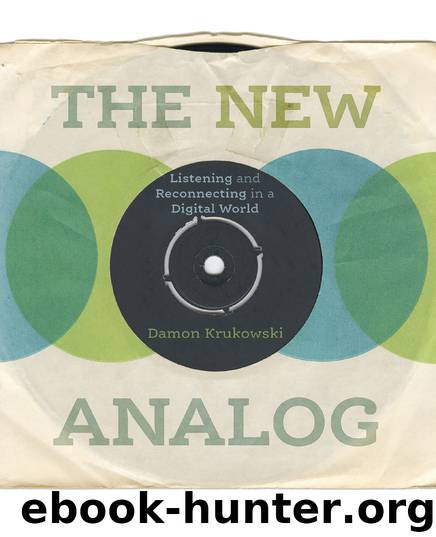The New Analog: Listening and Reconnecting in a Digital World by Damon Krukowski

Author:Damon Krukowski [Krukowski, Damon]
Language: eng
Format: azw3
ISBN: 9781620971987
Publisher: The New Press
Published: 2017-04-25T04:00:00+00:00
Tape Hiss
Just as there is a physical limit to the number of splices that might occupy a given length of tape—a limit John Cage seemed to approach on his very first pass, in Williams Mix—there is a limit to the number of overdubs possible in an analog medium. Tape itself is not silent as it moves through a recording machine; no more than we are in an anechoic chamber. Which means each overdub adds not only more signal but more noise, in the form of tape hiss. And layers of hiss don’t get more trippy, they just get louder.
One reason the great works of multitrack analog recording were made by artists with tremendous resources—the Beatles, the Beach Boys—is that it took the finest analog equipment to keep tape hiss at a minimum for that many passes through the machines. “Lo-fi” artists have made equally dense and psychedelic works; the Elephant 6 collective of the 1990s were still in high school when they started making theirs, on four-track cassette. But in analog recording, overdubs and tape hiss necessarily go hand in hand; only capital (or Capitol) can keep the latter manageable as the former pile up.
Even so, Sgt. Pepper’s and Pet Sounds are works of noise as well as signal. Those noises are not limited to tape hiss—they include all the many aural artifacts of the various times and spaces layered onto these short lengths of tape. A well-known example on Sgt. Pepper’s is the studio air-conditioning audible at the end of the album’s dramatic final chord. And obsessives have made use of internet crowdsourcing to catalog all the many noises married to the signals on Beach Boys recordings.8 Here is the list just for the song “Here Today,” from Pet Sounds:
1:15 Mike starts singing the chorus too soon. “She made me feel” and then someone else says something to make Mike stop
1:27 Something metallic is dropped at the point: “She made my heart feel sad. Sh(drop)e made my days go wrong . . .” of the second chorus.
1:46 Brian says “Top” as soon as the second chorus ends to rewind the tapes and start the take over
1:52 Someone says something supposedly about cameras
1:56 Someone else replies to the person at 1:52
2:03 Brian says “Top please,” probably because he realizes the tape is still rolling after all these noises
2:20 Talking
These inadvertent noises are inseparable from the intended signals on the tape. Had Brian Wilson wanted to get rid of them, his only option would have been to rerecord the entire track on which they occurred. Had that track already been bounced along with others in a reduction mix, it would mean rerecording all those tracks too. And had the unintended sounds gone undetected until the final mix, as often happens, it would mean throwing away the complete recording and starting all over again.
Analog recording is an additive process. Whatever happened in the studio as each layer was added, happens again on the tape as it unspools. For all the Abbey Road
Download
This site does not store any files on its server. We only index and link to content provided by other sites. Please contact the content providers to delete copyright contents if any and email us, we'll remove relevant links or contents immediately.
| Anthropology | Archaeology |
| Philosophy | Politics & Government |
| Social Sciences | Sociology |
| Women's Studies |
Cecilia; Or, Memoirs of an Heiress — Volume 1 by Fanny Burney(32040)
Cecilia; Or, Memoirs of an Heiress — Volume 3 by Fanny Burney(31446)
Cecilia; Or, Memoirs of an Heiress — Volume 2 by Fanny Burney(31395)
The Great Music City by Andrea Baker(30767)
We're Going to Need More Wine by Gabrielle Union(18620)
All the Missing Girls by Megan Miranda(14658)
Pimp by Iceberg Slim(13766)
Bombshells: Glamour Girls of a Lifetime by Sullivan Steve(13676)
Fifty Shades Freed by E L James(12897)
Talking to Strangers by Malcolm Gladwell(12844)
Norse Mythology by Gaiman Neil(12805)
For the Love of Europe by Rick Steves(11352)
Crazy Rich Asians by Kevin Kwan(8875)
Mindhunter: Inside the FBI's Elite Serial Crime Unit by John E. Douglas & Mark Olshaker(8683)
The Lost Art of Listening by Michael P. Nichols(7150)
Enlightenment Now: The Case for Reason, Science, Humanism, and Progress by Steven Pinker(6864)
The Four Agreements by Don Miguel Ruiz(6304)
Bad Blood by John Carreyrou(6266)
Weapons of Math Destruction by Cathy O'Neil(5813)
